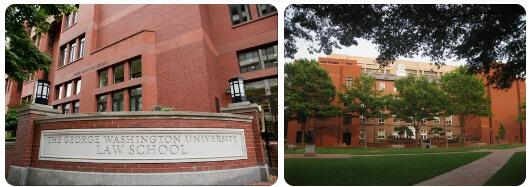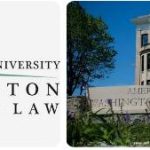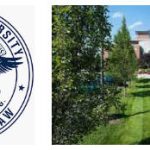George Washington University Law School was founded in 1865 as the Columbian College Law Department. It is one of the oldest law schools in the United States. The first class of students enrolled in 1866 and graduated two years later, setting a record for the shortest period of study for any law school in the United States at that time. Since then, GW Law has been dedicated to providing a rigorous legal education to its students and has become one of the most respected law schools in the country. Throughout its history, GW Law has been committed to educating lawyers who are committed to public service, justice, and professional excellence. The school has produced an impressive list of alumni who have gone on to achieve great success both inside and outside of the legal profession. In addition to its rigorous academic program, GW Law also offers an array of student organizations, clinics, internships, and other opportunities that provide students with valuable real-world experience and networking opportunities. Through these experiences and resources, GW Law graduates are well-prepared for successful careers as lawyers or leaders in their chosen fields.
George Washington University Law School is located in Washington DC. As one of the leading law programs, George Washington University Law School has a high average LSAT score of 163-168 when recruiting new students. As a return, the median starting salary for law graduates reaches $160,000 per year. See the following table for detailed admissions information and career profiles of George Washington University Law School.
Admissions: George Washington University
George Washington University Law School is one of the most prestigious law schools in the country. The school has a highly competitive admissions process, with an acceptance rate of only 25%. The average LSAT score for incoming students is 164, and the median GPA is 3.6. Incoming students come from a variety of backgrounds and have diverse experiences, with 19% identifying as non-white and 33% coming from outside the United States. Additionally, nearly 20% of incoming students are first-generation college students. GW Law School also boasts a low student-to-faculty ratio of 10:1, ensuring that each student receives individualized attention and support from their professors. The school has a wide range of academic offerings to meet the needs of all its students, including joint degree programs with other disciplines such as public policy and international affairs. Furthermore, GW Law offers many experiential learning opportunities both on campus and abroad through clinics, externships, internships and study abroad programs.
| Fall 2019 Admissions and Enrollment Statistics | |
|---|---|
| Total number of full- and part-time applicants | 9,592 |
| Total number of full- and part-time acceptances | 2,145 |
| Overall acceptance rate | 22.4% |
| Total number of full- and part-time first-year students enrolled | 506 |
| Number of full-time program applicants | 8,906 |
| Number of full-time program acceptances | 2,029 |
| Full-time acceptance rate | 22.8% |
| Number of first-year full-time students enrolled | 456 |
| Number of part-time program applicants | 686 |
| Number of part-time program acceptances | 116 |
| Part-time acceptance rate | 16.9% |
| Number of first-year part-time students enrolled | 50 |
| Fall 2019 GPA and LSAT Scores | |
| 25th-75th percentile GPA scores for all students | 3.41-3.86 |
| 25th-75th percentile LSAT scores for all students | 163-168 |
| 25th-75th percentile undergraduate GPA for full-time students | 3.45-3.86 |
| 25th-75th percentile LSAT scores for full-time students | 163-168 |
| 25th-75th percentile undergraduate GPA for part-time students | 3.16-3.83 |
| 25th-75th percentile LSAT scores for part-time students | 162-167 |
Careers: George Washington University
| Bar Statistics (Winter and Summer 2018 administrations) | |
|---|---|
| State where the greatest number of first-time test takers took the bar | NY |
| School’s bar passage rate for first-time test takers | 95.1% |
| Statewide bar passage rate for first-time test takers | 80.7% |
| Class of 2018 Graduates | |
| Total graduates | 529 |
| Graduates employed at graduation | 93.4% |
| Graduates known to be employed nine months after graduation | 98.9% |
| Starting Salaries of 2018 Graduates Employed Full-time | |
| 25th percentile private sector starting salary | $145,000 |
| Median private sector starting salary | $160,000 |
| 75th percentile private sector starting salary | $160,000 |
| Percent in the private sector who reported salary information | 87% |
| Median public service starting salary | $55,731 |
| Areas of Legal Practice (Class of 2018) | |
| Percent employed in academia | 2.0% |
| Percent employed in business and industry | 7.0% |
| Percent employed in government | 12.0% |
| Percent employed in all judicial clerkships | 9.0% |
| Percent employed in law firms | 66.0% |
| Percent employed in public interest | 4.0% |
| Percent employed in an unknown field | 0.0% |
| Percent employed in a judicial clerkship by an Article III federal judge | 3.2% |
| 2018 Graduates Employment Location | |
| Graduates employed in-state | 52% |
| Graduates employed in foreign countries | 0% |
| Number of states where graduates are employed | 26 |
| New England (CT, ME, MA, NH, RI, VT) | 3.0% |
| Middle Atlantic (NY, NJ, PA) | 17.0% |
| East North Central (IL, IN, MI, OH, WI) | 3.0% |
| West North Central (IA, KS, MN, MO, NE, ND, SD) | 0.0% |
| South Atlantic (DE, DC, FL, GA, MD, NC, SC, VA, WV) | 64.0% |
| East South Central (AL, KY, MS, TN) | 1.0% |
| West South Central (AR, LA, OK, TX) | 1.0% |
| Pacific (AK, CA, HI, OR, WA) | 6.0% |
| Mountain (AZ, CO, ID, MT, NV, NM, UT, WY) | 2.0% |
| Employment location unknown | 3.0% |
| Career Services | |
| (Data appear as originally submitted by this school) | |
| Career services operations | 10 counselors (all former attorneys, various specialties) provide individual counseling, employment market insight, interview preparation. 700+ employers participate in recruitment programs; on-site Resource Library, Simplicity Job Bank/Judge Database, frequent portal/e-mail opportunity announcements; clerkship director and dedicated faculty/staff; active alumni network, strong D.C. connections. |
| Job Type | |
| Bar admission required or anticipated (e.g., attorney and corporate counsel positions, law clerks, judicial clerks) | 92.0% |
| J.D. preferred, law degree enhances position (e.g., corporate contracts administrator, alternative dispute resolution specialist, government regulatory analyst, FBI special agent) | 2.0% |
| Professional/other (jobs that require professional skills or training but for which a J.D. is neither preferred nor particularly applicable; e.g., accountant, teacher, business manager, nurse) | 2.0% |
| Nonprofessional/other (job that does not require any professional skills or training or is taken on a temporary basis and not viewed as part of a career path) | 0.0% |









